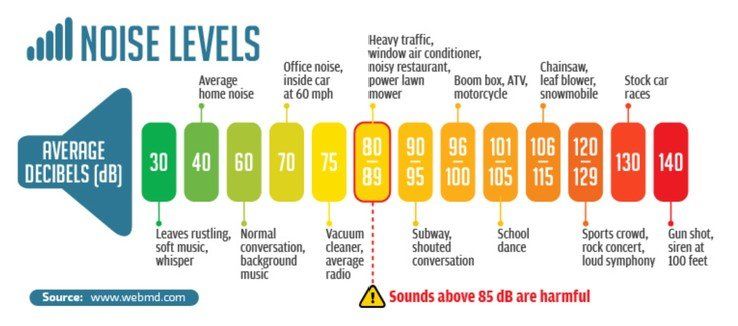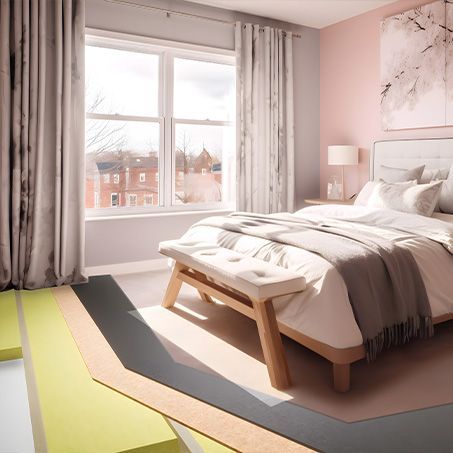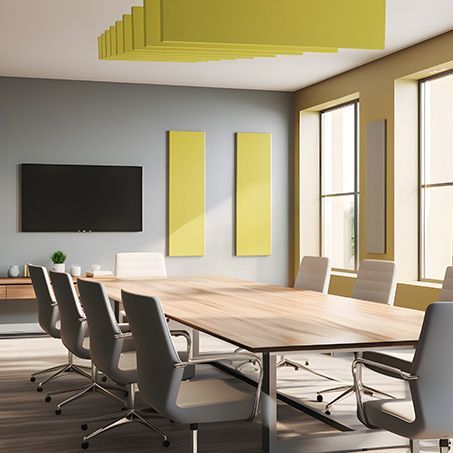DECIBELS EXPLAINED
What is a decibel (dB) and how is sound measured?
Decibels are measured logarithmically (it is not a percentage). This is a way of counting or measuring something that increases rapidly, or exponentially. For example, every increase of 10dB on the decibel scale is equal to a 10-fold increase in sound pressure level (SPL). Near silence is expressed as 0dB but a sound measured at 10dB is actually 10 times louder. If a sound is 20dB, that's 100 times louder than near silence.
Our ears detect changes in volume in a non-linear fashion. A difference of 1 decibel is perceived as a minimum change in volume, 3dB is a moderate change, and 10 decibels is perceived by the listener as a doubling of volume.
Another example is if your TV is on volume 10 and you turn it up to 20 this would be a doubling of the noise (I.E a 10dB increase) and if you then turn your TV up again by another 10dB your TV would now be on a volume of 40 (not 30) and again another 10dB would be a TV volume of 80.
Finally, a decibel is an average of all the sound frequencies played at the same volume. However, in the real world a noise that is high in the lower base frequency and low in the high frequency will show the same decibel reading as a noise that is loud in the high frequencies but low in the base frequencies.

Technical Definition
The decibel (abbreviated dB) is possibly the most misunderstood measurement since the cubit, (an ancient unit of length based on the length of the forearm from the elbow to the tip of the middle finger). Although the term decibel always means the same thing, decibels may be calculated in several ways, and there are many confusing explanations of what they are.
The decibel is not a unit in the sense that a foot or a dyne is. Dyne's and feet are defined quantities of force and distance. (You can go to the National Bureau of Standards and look at a foot or a dyne if you want to. They never change.) A decibel is a RELATIONSHIP between two values of POWER.
Decibels are designed for talking about numbers of greatly different magnitude, such as 23 vs. 4,700,000,000,000. With such vast differences between the numbers, the most difficult problem is getting the number of zeros right. We could use scientific notation, but a comparison between 2.3 X 10 and 4.7 X 10 to the 12th is still awkward. For convenience, we find the RATIO between the two numbers and convert that into a logarithm. This gives a number like 11.3. As long as we are going for simplicity, we might as well get rid of the decimal, so we multiply the number times ten. If we measured one value as 23 hp and another as 4.7 trillion hp, we say that one is 113dB greater than the other.
The usefulness of all this becomes apparent when we think about how the ear perceives loudness. First of all, the ear is very sensitive. The softest audible sound has a power of about 0.000000000001 watt/sq. meter and the threshold of pain is around 1 watt/sq. meter, giving a total range of 120dB. In the second place, our judgment of relative levels of loudness is somewhat logarithmic. If a sound has 10 times the power of a reference (10dB) we hear it as twice as loud. If we merely double the power (3dB), the difference will be just noticeable.
[The calculations for the dB relationships I just gave go like this; for a 10 to one relationship, the log of 10 is 1, and ten times 1 is 10. For the 2 to one relationship, the log of 2 is 0.3, and 10 times that is 3. Incidentally, if the ratio goes the other way, with the measured value less than the reference, we get a negative dB value, because the log of 1/10 is -1.]
Definition: A decibel, or its abbreviation dB is a measurement of loudness that ranges from the threshold of hearing, 0dB to the threshold of pain, about 140dB. The term decibel is actually two words: deci, meaning one-tenth, and bel, named after Alexander Graham Bell, the inventor of the telephone, which is why the 'B' is always written in upper case as in dB. So, a decibel is actually one-tenth of a unit of sound measurement known as a bel.
How is sound measured in homes
dB Reduction Figures Explained
The first thing to explain is that sound reduction can be tested in many different ways, and overall sound reduction figures can be calculated in many different ways. A good comparison is how you can calculate an average figure from multiple figures as a mean average, median average or modal average depending on how you want the calculation to be weighted.
Building regulations sound testing is based on ISO 717 -1 (Airborne Sound) / -2 (Impact Sound). This is a standardized test where sound covering a frequency range from 100Hz to 3150Hz is played on one side of an assembly at around 100dB. The sound is then measured on the other side of the assembly. The sound reduction is then calculated across the frequency range, and then averaged for a final sound reduction figure.
Below is a glossary of different sound reduction figures to explain the differences.
Airborne Test Figures
-
RwItem Link List Item 1
Rw is the weighted sound reduction index in dB (decibels) and it describes the airborne sound insulating power of a building element. It is a laboratory measured value as defined in ISO 717-1. It can apply to walls, ceilings, floors, roofs, doors or windows. The higher the number, the greater the sound insulating power of the element.
An increase in the Rw of a wall by 6 points will reduce the perceived loudness of sound passing through the wall by about half.
*used in building regulations for internal walls and floors
-
Rw + CtrItem Link List Item 2
Rw+Ctr is the Rw figure with the addition of a low frequency sound correction factor Ctr (a negative number). The use of Rw+Ctr has become more relevant due to the increase in low frequency sound sources such as surround sound systems, traffic and aircraft noise, drums and bass guitars and home entertainment equipment. Two walls can have the same Rw rating, but have different resistance to low frequency sound, thus a different Rw+Ctr
-
DnTwItem Link List Item 3
DnT,w is the equivalent of Rw, but measured on-site instead of in a laboratory setting.
*used in Scottish building regulations for walls and floors separating dwellings
-
DnTw +CtrItem Link List Item 4
DnT,w+Ctr is the equivalent of Rw+Ctr, but measured on-site instead of in a laboratory setting. This is the DnT,w figure with the addition of a low frequency sound correction factor.
*used in building regulations in England, Wales and N.Ireland for walls and floors separating dwellings
Impact Test Figures
-
Ln,wItem Link List Item 1
Ln,w describes how easily impact sound travels through a floor assembly. Ln,w is a laboratory measured value as defined in ISO 717-2.
Unlike airborne figures such as Rw, better performing floors have lower values not higher values.
-
LnT,wItem Link List Item 2
LnT,w is the equivalent of Ln,w but measured on-site instead of in a laboratory
*used in building regulations across the UK for floors separating dwellings
Why Soundproofing dB figures are only a guide?
The UK's Most Trusted
Soundproofing Provider
Providing friendly, expert advice and high performing, DIY soundproofing solutions. Empowering you to achieve peace and quiet in your home
We don’t expect you to become an overnight soundproofing expert, that’s what we’re here for.
We let our customers do the talking
Useful Links:
Contact Info:
Opening Times:
Mon - Fri: 9:00am - 5:00pm
Sat - Sun: Closed
Join Our Newsletter
Join Our Newsletter
Thank you for contacting us.
We will get back to you as soon as possible
www.soundproofingstore.co.uk
01423 206208
sales@soundproofingstore.co.uk
Please try again later














